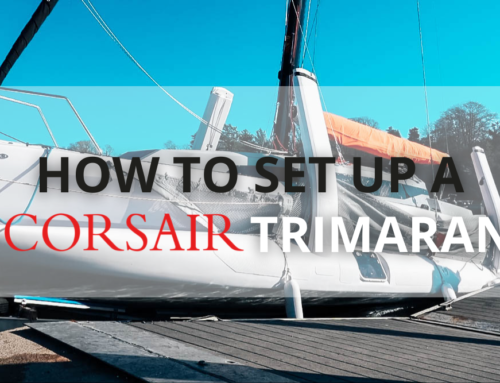Trimaran Antifouling FAQ’s
QUESTION: “Long time multi huller. Want to purchase F-24 and leave at dock in lake for immediate ease of use. Do I have to worry about hull blistering? What bottom paint do you suggest? I only want to paint bottom to keep brown lake gunge off boat. How do I find the lines for painting?”
Randy Chapman
This is a question that we are frequently asked and as with most things there is more than one answer that will get the job done. These are my tips for a tidy antifoul job…
Step 1
Sit the boat down in flat water and using a permanent marker make a fore and aft mark on each of the hulls approximately 75mm (3″) above the water line.
Step 2
Bring the boat back out of the water and prop up the unfolded Corsair under each of the beams just outboard of the folding strut attachments. Once you are properly secured you can remove the trailer giving you full access to the hull bottoms. The acro props will support the trimaran however I like to bear on the side of caution and place some blocks under the main hull as a safety measure. These can be removed while you are painting.
Now clean down the hull with acetone or other thinners. Take come quality 1″ masking tape and connect the two marks on the side of each hull. It will become tricky at the bows and stern where the hull shape changes dramatically. Just stand make and eye off the tape to check it is in line. I find it best to hold the tape roll about 1m (3-4′) away from the hull when applying, this ensures you don’t wander the tape line up and down along the water line. Then with your free hand just wipe pressure over the tape to stick it down to the hull. If you don’t get it right first time, don’t worry just remove the area that needs re alignment and reapply, re using the same length of tape.
Step 3
Now that you are taped up you will need to prepare the surface for the epoxy primer. You first need to apply a guide coat to the surface. If you don’t have any, a cheap hack is to 1/2 fill a small soft drink bottle with acetone and then spray in some cheap spray paint until you have a colored solution. Keep applying paint until the mixture is thick enough to apply to the hull with a rag. Next comes the hard work….sanding. You will need a machine for this, an orbital sander is the tool of choice for this job. Using a soft backing pad with some 180 grade sand paper sand all the surfaces until the guide coat is no longer visible and there is no shiny gelcoat left. Don’t go right up to the tape line with the tool, finish this area off by hand.
Step 4
Now go around the tape line and apply a second strip of 2″ tape to protect from any run overs. wipe all the dust off the hull and then go over everything with acetone or alcohol to clean the surface.
Step 5
My preferred brand of antifoul is Altex. I use Altex #1 epoxy primer and Altex #5 antifoul. There are many other good brands out there, I base this choice on years of positive experience with the Altex product. It is important to choose a good roller that will provide a smooth finish. If you have back problems look for an extension that will allow you to do the job at a comfortable height. (Safety first! Antifoul contains a number of hazardous chemicals that are extremely harmful if consumed, ensure you use a good respirator with charcoal filter and safety glasses) For the application and mixing be sure to read the instructions on the can from top to bottom and ensure you mix well and allow the epoxy primer to sit for 10 -15 minutes before applying. I generally leave each coat for 8 to 12 hours before re applying however this will be determined by your climate and product choice. For me the 8-12 hours works well as I always follow the same schedule.
Day 1 Morning 7am: Primer
Day 1 Evening 4pm: 1’st coat Antifoul
Day 2 Morning: 2nd coat Antifoul
As you see I usually apply two coats however you should adjust this to your experiences in your local waters and required time frame between re application.





